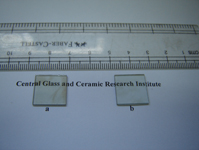Crossref Citations
This article has been cited by the following publications. This list is generated based on data provided by
Crossref.
Mandal, Ashis K.
Balaji, S.
and
Sen, Ranjan
2014.
Microwave and conventional preparation of Zinc borate glass: Eu 3+ ion as luminescent probe.
Journal of Alloys and Compounds,
Vol. 615,
Issue. ,
p.
283.
Mandal, Ashis
and
Sen, Ranjan
2015.
Microwave Absorption of Barium Borosilicate, Zinc Borate, Fe-Doped Alumino-Phosphate Glasses and Its Raw Materials.
Technologies,
Vol. 3,
Issue. 2,
p.
111.
Mandal, Ashis K.
Sinha, Prasanta K.
Das, Dipankar
Guha, Chandan
and
Sen, Ranjan
2015.
Higher Fe2+/total Fe ratio in iron doped phosphate glass melted by microwave heating.
Materials Research Bulletin,
Vol. 63,
Issue. ,
p.
141.
Mandal, Biswajit
Halder, Avik
Sinha, Prasanta Kumar
Sen, Ranjan
and
Mandal, Ashis Kumar
2016.
Investigation of iron redox ratio in zinc borate glass prepared in microwave heating and comparison with conventional glass.
Journal of Non-Crystalline Solids,
Vol. 450,
Issue. ,
p.
12.
Bhattacharya, Madhuchhanda
and
Basak, Tanmay
2016.
A review on the susceptor assisted microwave processing of materials.
Energy,
Vol. 97,
Issue. ,
p.
306.
Mandal, Biswajit
Sinha, Prasanta Kumar
Sen, Ranjan
and
Mandal, Ashis Kumar
2016.
A Comparative Spectrophotometric Study Using Ferrozine and 1,10-Ortho-phenanthroline to Evaluate the Iron Redox Ratio (Fe2+/ΣFe) in Glass Prepared by Microwave Heating.
Analytical Sciences,
Vol. 32,
Issue. 5,
p.
571.
Halder, Avik
Mandal, Biswajit
Mahanty, Sourindra
Sen, Ranjan
and
Mandal, Ashis Kumar
2017.
A comparative property investigation of lithium phosphate glass melted in microwave and conventional heating.
Bulletin of Materials Science,
Vol. 40,
Issue. 5,
p.
999.
Ramrakhiani, Lata
Halder, Avik
Majumder, Abhradeep
Mandal, Ashis K.
Majumdar, Swachchha
and
Ghosh, Sourja
2017.
Industrial waste derived biosorbent for toxic metal remediation: Mechanism studies and spent biosorbent management.
Chemical Engineering Journal,
Vol. 308,
Issue. ,
p.
1048.
Mandal, Ashis K.
and
Sen, Ranjan
2017.
An overview on microwave processing of material: A special emphasis on glass melting.
Materials and Manufacturing Processes,
Vol. 32,
Issue. 1,
p.
1.
Mandal, Ashis K.
and
Sen, Ranjan
2018.
Preservation of higher Fe[II] content in borosilicate glass by microwave irradiation in air.
Materials Research Bulletin,
Vol. 108,
Issue. ,
p.
156.
Mandal, Ashis K.
Mandal, B.
Illath, Kavya
Ajithkumar, T. G.
Halder, A.
Sinha, P. K.
and
Sen, Ranjan
2018.
Preparation of colourless phosphate glass by stabilising higher Fe[II] in microwave heating.
Scientific Reports,
Vol. 8,
Issue. 1,
Ramrakhiani, L.
Halder, A.
Mandal, A. K.
Majumdar, S.
and
Ghosh, S.
2018.
Utilization and Management of Bioresources.
p.
301.
Horikoshi, Satoshi
Schiffmann, Robert F.
Fukushima, Jun
and
Serpone, Nick
2018.
Microwave Chemical and Materials Processing.
p.
213.
Basak, Arijit
Ramrakhiani, Lata
Ghosh, Sourja
Sen, Ranjan
and
Mandal, Ashis K.
2018.
Preparation of chromium doped phosphate glass adopting microwave irradiation and comparative analysis of properties with conventional glass.
Journal of Non-Crystalline Solids,
Vol. 500,
Issue. ,
p.
11.
Ramrakhiani, Lata
Ghosh, Sourja
Mandal, Ashis K.
and
Majumdar, Swachchha
2019.
Utilization of multi-metal laden spent biosorbent for removal of glyphosate herbicide from aqueous solution and its mechanism elucidation.
Chemical Engineering Journal,
Vol. 361,
Issue. ,
p.
1063.
Mandal, Ashis Kumar
and
Sen, Ranjan
2019.
Optimization of melting parameters and minimizing OH content in SiO2‐B2O3‐Na2O‐BaO glass system in microwave heating.
International Journal of Applied Glass Science,
Vol. 10,
Issue. 1,
p.
83.
Mandal, Yudhisthir
Sinha, Prasanta K
and
Mandal, Ashis Kumar
2021.
Effect of melting time on volatility, OH in glass in microwave processing.
Materials and Manufacturing Processes,
Vol. 36,
Issue. 4,
p.
426.
Das, Biplab
and
Mandal, Ashis Kumar
2022.
A comparative study on copper doped sodium alumina-phosphate glass with conventional and microwave heating.
Optical Materials,
Vol. 134,
Issue. ,
p.
113146.
Singh, Charanjit
Khanna, Virat
and
Singh, Satnam
2023.
Sustainability of microwave heating in materials processing technologies.
Materials Today: Proceedings,
Vol. 73,
Issue. ,
p.
241.
Das, Biplab
Ghosh, Sourja
Majumder, Swachchha
and
Mandal, Ashis Kumar
2024.
Arsenic-contaminated sludge remediation induced generation of coloured glass using conventional and microwave heating.
Clean Technologies and Environmental Policy,





